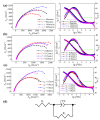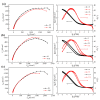Surface Integrity and Corrosion Resistance of 42CrMo4 High-Strength Steel Strengthened by Hard Turning
- PMID: 34832395
- PMCID: PMC8624469
- DOI: 10.3390/ma14226995
Surface Integrity and Corrosion Resistance of 42CrMo4 High-Strength Steel Strengthened by Hard Turning
Abstract
To improve the surface corrosion resistance of 42CrMo4 high-strength steel used in a marine environment, this article studied the effects of hard turning on the surface integrity and corrosion resistance of 42CrMo4 high-strength steel through the single factor experimental method, namely hard turning, polarization corrosion, electrochemical impedance spectroscopy, potentiodynamic polarization curve, and salt spray tests. The results indicated that the surface integrity was modified by the hard turning, with a surface roughness lower than Ra 0.8 μm, decreased surface microhardness, fine and uniform surface microstructure, and dominant surface residual compressive stress. The hard turning process was feasible to strengthen the surface corrosion resistance of 42CrMo4 high-strength steel. The better corrosion resistance of the surface layer than that of the substrate material can be ascribed to the uniform carbides and compact microstructure. The corrosion resistance varied with cutting speeds as a result of the changed surface microhardness and residual compressive stress, varied with feed rates as a result of the changed surface roughness, and varied with cutting depths as a result of the changed surface residual compressive stress, respectively. The surface integrity with smaller surface roughness and microhardness and bigger surface residual compressive stress was beneficial for corrosion resistance.
Keywords: 42CrMo4 steel; corrosion resistance; hard cutting; surface integrity.
Conflict of interest statement
The authors declare no conflict of interest.
Figures


















References
-
- Li B., Zhang S., Hu R., Zhang X. Dislocation density and grain size evolution in hard machining of H13 steel: Numerical and experimental investigation. J. Mater. Res. Technol. 2020;9:4241–4254. doi: 10.1016/j.jmrt.2020.02.051. - DOI
-
- Abbas A.T., Anwar S., Hegab H., Benyahia F., Ali H., Elkaseer A. Comparative evaluation of surface quality, tool wear, and specific cutting energy for wiper and conventional carbide inserts in hard turning of AISI 4340 alloy steel. Materials. 2020;13:5233. doi: 10.3390/ma13225233. - DOI - PMC - PubMed
-
- Kara F., Karabatak M., Ayyildiz M., Nas E. Effect of machinability, microstructure and hardness of deep cryogenic treatment in hard turning of AISI D2 steel with ceramic cutting. J. Mater. Res. Technol. 2020;9:969–983. doi: 10.1016/j.jmrt.2019.11.037. - DOI
-
- Kene A.P., Choudhury S.K. Analytical modeling of tool health monitoring system using multiple sensor data fusion approach in hard machining. Measurement. 2019;145:118–129. doi: 10.1016/j.measurement.2019.05.062. - DOI
-
- Bushlya V., Petrusha I., Gutnichenko O., Osipov O., M’Saoubi R., Turkevich V., Ståhl J.E. Sintering of binderless cubic boron nitride and its modification by β-Si3N4 additive for hard machining applications. Int. J. Refract. Met. Hard Mater. 2020;86:105100. doi: 10.1016/j.ijrmhm.2019.105100. - DOI
Grants and funding
LinkOut - more resources
Full Text Sources

